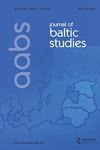17世纪立陶宛大公国丧葬文学中的抒情诗:一部作品的故事
IF 0.5
4区 社会学
Q2 AREA STUDIES
引用次数: 0
摘要
16世纪末至17世纪初,立陶宛大公国出现了抒情诗作品。其中一个包含抒情诗的文学领域是葬礼文学,主要是为贵族或教会精英的葬礼而写的作品。更有趣的作品之一是1603年的《Funebria》,由Ioannes Kimbar用拉丁文写成。这幅作品是献给大公国军官(rotmistrz) Theodorus Lacki(1554-1610)的妻子Isabella Bonarelli(1567-1602)的。这篇文章将集中讨论《Funebria》结尾部分的抒情诗,并解释这些抒情诗在当时大公国葬礼文学的背景下是如何脱颖而出的。关键词:新拉丁文学、诗歌、17世纪立陶宛大公国的丧葬作品ioannes KimbarTheodorus lackisabella Bonarelli披露声明作者未报告潜在的利益冲突。参见narbutienvilandnarbutas (Citation2002)。目录中有29件哀悼作品(从1545年到1600年),其中只有四件是纪念女性死亡的:第84号,第324号,第53号和第61号。17世纪初的情况也类似:到1610年,立陶宛印刷了13本拉丁文哀悼作品,其中只有两本(第476号和第141号)与尊重妇女直接相关(见narbutienkii和Narbutas Citation1998)。该出版物已被数字化,可在这里查阅:http://elibrary.mab.lt/handle/1/282143。在那个时候,诺沃拉拉是一个矮小的城邦,属于冈萨加的一个分支,冈萨加是意大利最强大的贵族家族之一。这个家族是11世纪诺曼底公爵理查德之子威廉的后裔。更可靠的信息来自13世纪末到14世纪初。这个家族有三个主要的分支,伊莎贝拉的父亲属于其中最小的一个。彼得罗是乌尔比诺公爵Guidubaldo II的朝臣和官员,但在他死后,他被指控挪用公款,并失去了后者的儿子弗朗西斯·玛丽亚的支持,被迫逃离。最初,他在费拉拉避难,并从1575年开始在诺瓦拉拉定居,诺瓦拉拉属于卡米尔·冈萨加,冈萨加家族诺瓦拉拉分支的成员。彼得罗有四个儿子和三个女儿。更多关于彼得罗的生平,见Barilli (Citation2010, 37-55)。7.与Threni in exequias Catharinae Radivilae de Teczyn的比较(citation), IV, 13-14:“Non praelustre genus, mores, Non inclyta virtus/Ulterius poterunt te retinere mihi?”8.与Threni在exequias Catharinae Radivilae de Teczyn中的比较(citation), IV, 23-24:“Illa recursabit quoties, non - ire tepentes/ in lachrymas toties coget amore tui.”比较与Threni在exequias Catharinae Radivilae de Teczyn (Citation1592), IV, 27-28: ' Ora moves, signasque manu, dare verbo marito/Supremumque“vale”dicere forte paras。关于contributorsŽivilė NedzinskaiteŽivilė的注释nedzinskaitnik,博士(人文),是立陶宛文学和民间传说研究所早期文学系的高级研究员。本文章由计算机程序翻译,如有差异,请以英文原文为准。
Lyrical poetry in funeral literature of the seventeenth century Grand Duchy of Lithuania: a story of one work
ABSTRACTIn the late sixteenth – early seventeenth century, works of lyrical poetry appeared in the Grand Duchy of Lithuania. One of the areas of literature that contained lyrical poetry was funeral literature, works mainly dedicated to the funerals of nobles or church elites. One of the more interesting works is Funebria (1603), written in Latin by Ioannes Kimbar. This work is dedicated to Isabella Bonarelli (1567–1602), the wife of Theodorus Lacki (1554–1610), an officer (rotmistrz) of the Grand Duchy. This article will focus on the lyrical poems that form the concluding part of Funebria, and will also explain how these lyrical poems stand out in the context of the Grand Duchy’s funeral literature of the time.KEYWORDS: Neo-Latin literaturelyrical poetryfunerary works in the Grand Duchy of Lithuania, seventeenth centuryIoannes KimbarTheodorus LackiIsabella Bonarelli Disclosure statementNo potential conflict of interest was reported by the author(s).Notes1. See Narbutienė and Narbutas (Citation2002). There are 29 mourning works in the catalog (from 1545 to 1600), of which only four commemorate the death of women: No. 84, 324, 53, and 61. The situation was similar at the beginning of the seventeenth century: by 1610, 13 mourning works in Latin were printed in Lithuania, and only two of them (No. 476 and 141) were directly related with the honoring of women (see Narbutienė and Narbutas Citation1998).2. The publication has been digitized and is available here: http://elibrary.mab.lt/handle/1/282143. At that time, Novellara was a dwarf city-state belonging to a branch of the Gonzaga, one of the most powerful Italian aristocratic families.4. The family is derived from William, son of Richard, Duke of Normandy in the eleventh century. More reliable information comes from the late thirteenth – early fourteenth century. There are three main branches of the family, and Isabella’s father belonged to the youngest of them.5. Pietro was a courtier and official of Guidubaldo II, Duke of Urbino, but after his death he was accused of embezzlement and fell out of favor with the latter’s son, Francis Maria, and was forced to flee. Initially, he took refuge in Ferrara and from 1575 settled in Novellara, which belonged to Kamil Gonzaga, a member of the Novellara branch of the Gonzaga family. Pietro had four sons and three daughters. For more on Pietro’s life, see Barilli (Citation2010, 37-55).6. Compare with Threni in exequias Catharinae Radivilae de Teczyn (Citation1592), IV, 13–14: ‘Non praelustre genus, mores, non inclyta virtus/Ulterius poterunt te retinere mihi?’7. Compare with Threni in exequias Catharinae Radivilae de Teczyn (Citation1592), IV, 23–24: ‘Illa recursabit quoties, non ire tepentes/In lachrymas toties coget amore tui.’8. Compare with Threni in exequias Catharinae Radivilae de Teczyn (Citation1592), IV, 27–28: ‘Ora moves, signasque manu, dare verbo marito/Supremumque “vale” dicere forte paras.’Additional informationNotes on contributorsŽivilė NedzinskaiteŽivilė Nedzinskaitė, PhD (Humanities), is a senior researcher at the Department of Early Literature of the Institute of Lithuanian Literature and Folklore.
求助全文
通过发布文献求助,成功后即可免费获取论文全文。
去求助
来源期刊

Journal of Baltic Studies
AREA STUDIES-
CiteScore
1.20
自引率
0.00%
发文量
52
期刊介绍:
The Journal of Baltic Studies, the official journal of the Association for the Advancement of Baltic Studies (AABS), is a peer-reviewed, multidisciplinary journal for the purpose of advancing the accumulation of knowledge about all aspects of the Baltic Sea region"s political, social, economic, and cultural life, past and present. Preference is given to original contributions that are of general scholarly interest. The Association for the Advancement of Baltic Studies is an international, educational, and scholarly non-profit organization. Established in 1968, the purpose of the Association is the promotion of research and education in Baltic Studies.
 求助内容:
求助内容: 应助结果提醒方式:
应助结果提醒方式:


